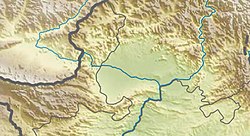| Aramaic inscription of Taxila | |
|---|---|
 Aramaic inscription of Taxila. | |
| Material | Portion of octagonal marble pillar. |
| Size | 200px |
| Writing | Aramaic |
| Created | circa 260 BCE |
| Period/culture | 3rd Century BCE |
| Discovered | 33.7561N 72.8292E |
| Place | Sirkap, Taxila, Pakistan |
| Present location | Taxila Museum, Pakistan |
| Location | |
Location of the Aramaic Inscription of Taxila. | |
| Part of a series on |
| Canaanite and Aramaic inscriptions |
|---|
 |
The Aramaic inscription of Taxila is an inscription on a piece of marble, originally belonging to an octagonal column, discovered by Sir John Marshall in 1915 at Taxila, British India. The inscription is written in Aramaic, probably by the Mauryan emperor Ashoka around 260 BCE, and often categorized as one of the Minor Rock Edicts. [1] Since Aramaic was the official language of the Achaemenid Empire, which disappeared in 330 BCE with the conquests of Alexander the Great, it seems that this inscription was addressed directly to the populations of this ancient empire still present in northwestern India, or to border populations for which Aramaic remained the normal communication language. [2] The inscription is known as KAI 273.





